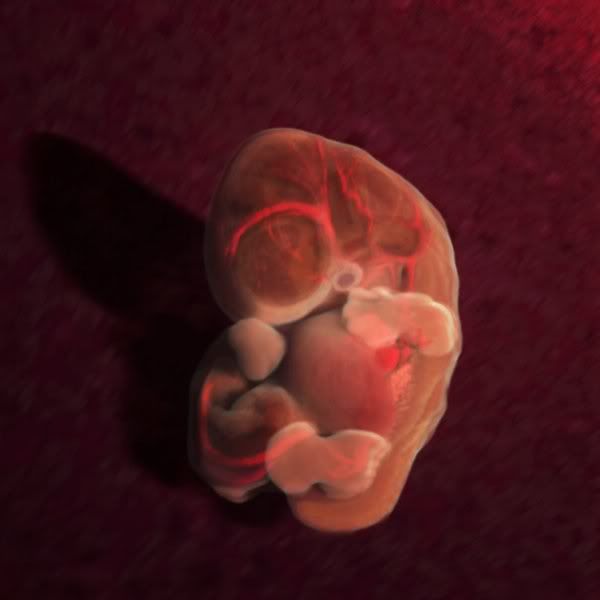Week 6 and 2days
"By this time, 38 pairs of somites have formed (the somites form
the bones and muscles of the head and trunk). Your baby’s brain
has differentiated into the three main parts possessed by all human
brains: the forebrain, the midbrain, and the hindbrain. Your baby is
about 3/8 inch (5–7 mm) long — about the size of a small coffee
bean — that’s 15,000 times bigger than at conception in only thirty days.
The embryonic cardiovascular system grows "ahead" of the baby,
stimulating new areas of development. At 6 weeks, it's possible to
see the tiny embryonic heart beating. Until this week, a human
embryo doesn't look very different from that of a mouse, a chicken,
or a pig--but all that is about to change. Though it's only about half
an inch (10-14 mm) long and weighs less than a paper clip, your
baby-to-be is starting to acquire a human face. The folds of the
eyelids and the jaws form, and the tip of the nose can be clearly seen.
Ears are developing inside and out: internally, the semicircular canals
are laid down, while externally mounds of tissue erupt where the whorls
of the ears will grow. The eyes become pigmented and continue their
incredibly complex development. Delicate eye muscles begin to form
and nerve cells appear in the retina.
Your little embryo's posture is improving. It loosens its tight,
curled-up position as the neck and trunk begin to grow and cartilage
and bone elongate throughout the body. The tail begins to shrink.
Fingers start to make their appearance as the hands become notched.
Several days later, toe notches appear in the foot plate.
~from The Cradle, pregnancy calendar

"By this time, 38 pairs of somites have formed (the somites form
the bones and muscles of the head and trunk). Your baby’s brain
has differentiated into the three main parts possessed by all human
brains: the forebrain, the midbrain, and the hindbrain. Your baby is
about 3/8 inch (5–7 mm) long — about the size of a small coffee
bean — that’s 15,000 times bigger than at conception in only thirty days.
The embryonic cardiovascular system grows "ahead" of the baby,
stimulating new areas of development. At 6 weeks, it's possible to
see the tiny embryonic heart beating. Until this week, a human
embryo doesn't look very different from that of a mouse, a chicken,
or a pig--but all that is about to change. Though it's only about half
an inch (10-14 mm) long and weighs less than a paper clip, your
baby-to-be is starting to acquire a human face. The folds of the
eyelids and the jaws form, and the tip of the nose can be clearly seen.
Ears are developing inside and out: internally, the semicircular canals
are laid down, while externally mounds of tissue erupt where the whorls
of the ears will grow. The eyes become pigmented and continue their
incredibly complex development. Delicate eye muscles begin to form
and nerve cells appear in the retina.
Your little embryo's posture is improving. It loosens its tight,
curled-up position as the neck and trunk begin to grow and cartilage
and bone elongate throughout the body. The tail begins to shrink.
Fingers start to make their appearance as the hands become notched.
Several days later, toe notches appear in the foot plate.
~from The Cradle, pregnancy calendar




